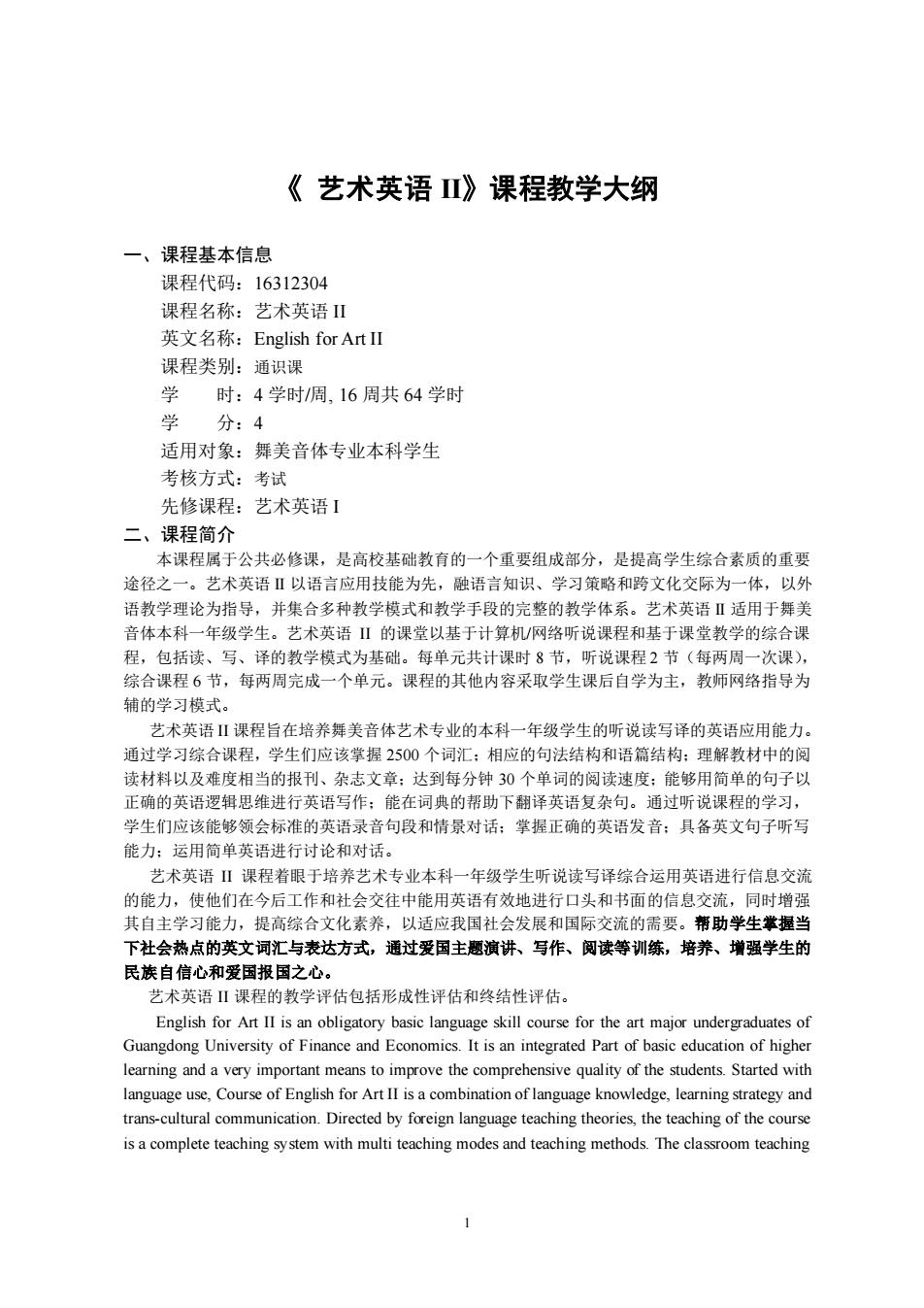
《艺术英语》课程教学大纲 一、课程基本信息 课程代码:16312304 课程名称:艺术英语Ⅱ 英文名称:English for ArtⅡ 课程类别:通识课 时:4学时/周,16周共64学时 学 分.4 适用对象:舞美音体专业本科学生 考核方式:考试 先修课程:艺术英语 二、课程简介 本课程属于公共必修课,是高校基础教育的一个重要组成部分,是提高学生综合素质的重要 途径之一。艺术英语Ⅱ以语言应用技能为先,融语言知识、学习策略和骑文化交际为一体,以 语教学理论为指导,并集合多种教学模式和教学手段的完整的教学体系。艺术英语Ⅱ适用于舞美 音体本科一年级学生。艺术英语Ⅱ的课堂以基于计算机/网络听说课程和基于课堂教学的综合课 程,包括读、写、译的教学模式为基础。每单元共计课时8节,听说课程2节(每两周一次课). 综合课程6节,每两周完成一个单元。课程的其他内容采取学生课后自学为主,教师网络指导为 辅的学习模式 艺术英语Ⅱ课程旨在培养舞美音体艺术专业的本科一年级学生的听说读写译的英语应用能力 通过学习综合课程,学生们应该掌握2500个词汇:相应的句法结构和语篇结构:理解教材中的阅 读材料以及难度相当的报刊、杂志文章:达到每分钟30个单词的阅读速度:能够用简单的句子以 正确的英语逻辑思维进行英语写作:能在词典的帮助下翻译英语复杂句。通过听说课程的学习, 学生们应该能够领会标 音句段和情景对话:掌握正确的英语发音:具备英文句 子听写 能力:运用简单英语进行讨论和对话。 艺术英语Ⅱ课程着眼于培养艺术专业本科一年级学生听说读写译综合运用英语进行信息交流 的能力,使他们在今后工作和社会交往中能用英语有效地进行口头和书面的信总交流,同时增强 其自主学习能力,提高综合文化素养,以适应我国社会发展和国际交流的需要。帮助学生掌握当 下社会热点的英文词汇与表达方式,通过爱国主题演讲、写作、阅读等训练,培养、增强学生的 民族自信心和爱国报国 之心。 艺术英语Ⅱ课程的教学评估包括形成性评估和终结性评估。 English for Art II is an obligatory basic language skill course for the art major undergraduates of Guangdong University of Finance and Economics.It is an integrated Part of basic education of higher learning and a very mprove the comprehen ve quality of the students.Started with language use,Course of English for Art II is a combination of language knowledge,learning strategy and trans-cultural communication.Directed by foreign language teaching theories,the teaching of the course is a complete teaching system with multi teaching modes and teaching methods.The classroom teaching 1
1 《 艺术英语 II》课程教学大纲 一、课程基本信息 课程代码:16312304 课程名称:艺术英语 II 英文名称:English for Art II 课程类别:通识课 学 时:4 学时/周, 16 周共 64 学时 学 分:4 适用对象:舞美音体专业本科学生 考核方式:考试 先修课程:艺术英语 I 二、课程简介 本课程属于公共必修课,是高校基础教育的一个重要组成部分,是提高学生综合素质的重要 途径之一。艺术英语 II 以语言应用技能为先,融语言知识、学习策略和跨文化交际为一体,以外 语教学理论为指导,并集合多种教学模式和教学手段的完整的教学体系。艺术英语 II 适用于舞美 音体本科一年级学生。艺术英语 II 的课堂以基于计算机/网络听说课程和基于课堂教学的综合课 程,包括读、写、译的教学模式为基础。每单元共计课时 8 节,听说课程 2 节(每两周一次课), 综合课程 6 节,每两周完成一个单元。课程的其他内容采取学生课后自学为主,教师网络指导为 辅的学习模式。 艺术英语 II 课程旨在培养舞美音体艺术专业的本科一年级学生的听说读写译的英语应用能力。 通过学习综合课程,学生们应该掌握 2500 个词汇;相应的句法结构和语篇结构;理解教材中的阅 读材料以及难度相当的报刊、杂志文章;达到每分钟 30 个单词的阅读速度;能够用简单的句子以 正确的英语逻辑思维进行英语写作;能在词典的帮助下翻译英语复杂句。通过听说课程的学习, 学生们应该能够领会标准的英语录音句段和情景对话;掌握正确的英语发音;具备英文句子听写 能力;运用简单英语进行讨论和对话。 艺术英语 II 课程着眼于培养艺术专业本科一年级学生听说读写译综合运用英语进行信息交流 的能力,使他们在今后工作和社会交往中能用英语有效地进行口头和书面的信息交流,同时增强 其自主学习能力,提高综合文化素养,以适应我国社会发展和国际交流的需要。帮助学生掌握当 下社会热点的英文词汇与表达方式,通过爱国主题演讲、写作、阅读等训练,培养、增强学生的 民族自信心和爱国报国之心。 艺术英语 II 课程的教学评估包括形成性评估和终结性评估。 English for Art II is an obligatory basic language skill course for the art major undergraduates of Guangdong University of Finance and Economics. It is an integrated Part of basic education of higher learning and a very important means to improve the comprehensive quality of the students. Started with language use, Course of English for Art II is a combination of language knowledge, learning strategy and trans-cultural communication. Directed by foreign language teaching theories, the teaching of the course is a complete teaching system with multi teaching modes and teaching methods. The classroom teaching
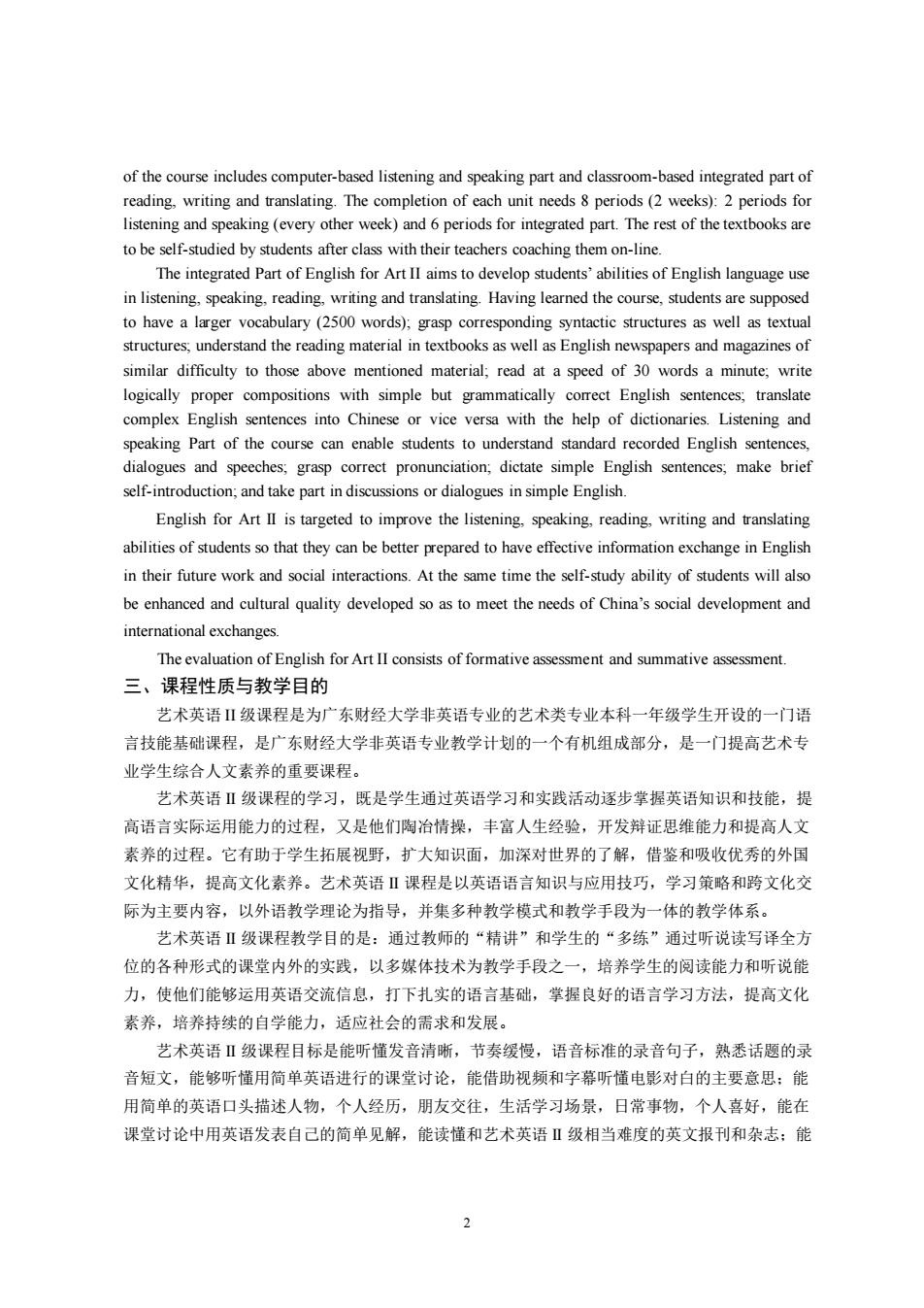
of the course includes computer-based listening and speaking part and classroom-based integrated part of reading,writing and translating.The completion of each unit needs 8 periods(2 weeks):2 periods for listening and speaking(every other week)and 6 periods for integrated part.The rest of the textbooks are to be self-studied by students after class with their teachers coaching them on-line. The integrated Part of Engish for Art to develop Engish in listening.speaking.reading.writing and translating.Having learned the course,students are supposed to have a larger vocabulary (2500 words):grasp corresponding syntactic structures as well as textual structures,understand the reading material in textbooks as well as English newspapers and magazines of similar difficulty to those above mentioned material;read at a speed of 30 words a minute:write logic y prope composition with simple but grammat rect English sentences,transla complex English sentences into Chinese or vice versa with the help of dictionaries.Listening and speaking Part of the course can enable students to understand standard recorded English sentences, dialogues and speeches,grasp correct pronunciation,dictate simple English sentences,make brief self-introduction:and take part in discussions or dialogues in simple English. English for Art lI is targeted to improve the listening.speaking.reading.writing and ranslating abilities of studentsso that they can be better prepared to have effective information exchange in English in their future work and social interactions.At the same time the self-study ability of students will also be enhanced and cultural quality developed so as to meet the needs of china's social development and international exchanges The evaluation of english for art li consists of formative a ssessment and summative assessment. 三、课程性质与教学目的 艺术英语Ⅱ级误程是为广东财经大学非英语专业的艺术类专业本科一年级学生开设的一门语 言技能基础课程,是广东财经大学非英语专业教学计划的一个有机组成部分,是一门提高艺术专 业学生综合人文素养的重要课程。 艺术英语Ⅱ级课程的学习,既是学生通过英语学习和实践活动逐步掌握英语知识和技能,提 高语言实际运用能力的过程,又是他们陶治情操,丰富人生经验,开发辩证思维能力和提高人文 素养的过程。它有助于学生拓展视野,扩大知识面,加深对世界的了解,借鉴和吸收优秀的外国 文化精华,提高文化素养。艺术英语Ⅱ课程是以英语语言知识与应用技巧,学习策略和跨文化交 际为主要内容。以外语教学理论为指导,并集名种教学模式和教学手段为一体的教学体系。 艺术英语Ⅱ级课程教学目的是:通过教师的“精讲”和学生的“多练”通过听说读写译全方 位的各种形式的课堂内外的实践,以多媒体技术为教学手段之一,培养学生的阅读能力和听说能 力,使他们能够运用英语交流信息,打下扎实的语言基础,掌握良好的语言学习方法,提高文化 素养,培养持续的自学能力,适应社会的需求和发展。 艺术英语Ⅱ级课程目标是能听懂发音清晰,节奏缓慢,语音标准的录音句子,熟悉话题的录 音短文,能够听懂用简单英语进行的课堂讨论,能借助视频和字幕听懂电影对白的主要意思:能 用简单的英语口头描述人物,个人经历,朋友交往,生活学习场景,日常事物,个人喜好,能在 课堂讨论中用英语发表自己的简单见解,能读懂和艺术英语Ⅱ级相当难度的英文报刊和杂志:能 2
2 of the course includes computer-based listening and speaking part and classroom-based integrated part of reading, writing and translating. The completion of each unit needs 8 periods (2 weeks): 2 periods for listening and speaking (every other week) and 6 periods for integrated part. The rest of the textbooks are to be self-studied by students after class with their teachers coaching them on-line. The integrated Part of English for Art II aims to develop students’ abilities of English language use in listening, speaking, reading, writing and translating. Having learned the course, students are supposed to have a larger vocabulary (2500 words); grasp corresponding syntactic structures as well as textual structures; understand the reading material in textbooks as well as English newspapers and magazines of similar difficulty to those above mentioned material; read at a speed of 30 words a minute; write logically proper compositions with simple but grammatically correct English sentences; translate complex English sentences into Chinese or vice versa with the help of dictionaries. Listening and speaking Part of the course can enable students to understand standard recorded English sentences, dialogues and speeches; grasp correct pronunciation; dictate simple English sentences; make brief self-introduction; and take part in discussions or dialogues in simple English. English for Art II is targeted to improve the listening, speaking, reading, writing and translating abilities of students so that they can be better prepared to have effective information exchange in English in their future work and social interactions. At the same time the self-study ability of students will also be enhanced and cultural quality developed so as to meet the needs of China’s social development and international exchanges. The evaluation of English for Art II consists of formative assessment and summative assessment. 三、课程性质与教学目的 艺术英语 II 级课程是为广东财经大学非英语专业的艺术类专业本科一年级学生开设的一门语 言技能基础课程,是广东财经大学非英语专业教学计划的一个有机组成部分,是一门提高艺术专 业学生综合人文素养的重要课程。 艺术英语 II 级课程的学习,既是学生通过英语学习和实践活动逐步掌握英语知识和技能,提 高语言实际运用能力的过程,又是他们陶冶情操,丰富人生经验,开发辩证思维能力和提高人文 素养的过程。它有助于学生拓展视野,扩大知识面,加深对世界的了解,借鉴和吸收优秀的外国 文化精华,提高文化素养。艺术英语 II 课程是以英语语言知识与应用技巧,学习策略和跨文化交 际为主要内容,以外语教学理论为指导,并集多种教学模式和教学手段为一体的教学体系。 艺术英语 II 级课程教学目的是:通过教师的“精讲”和学生的“多练”通过听说读写译全方 位的各种形式的课堂内外的实践,以多媒体技术为教学手段之一,培养学生的阅读能力和听说能 力,使他们能够运用英语交流信息,打下扎实的语言基础,掌握良好的语言学习方法,提高文化 素养,培养持续的自学能力,适应社会的需求和发展。 艺术英语 II 级课程目标是能听懂发音清晰,节奏缓慢,语音标准的录音句子,熟悉话题的录 音短文,能够听懂用简单英语进行的课堂讨论,能借助视频和字幕听懂电影对白的主要意思;能 用简单的英语口头描述人物,个人经历,朋友交往,生活学习场景,日常事物,个人喜好,能在 课堂讨论中用英语发表自己的简单见解,能读懂和艺术英语 II 级相当难度的英文报刊和杂志;能
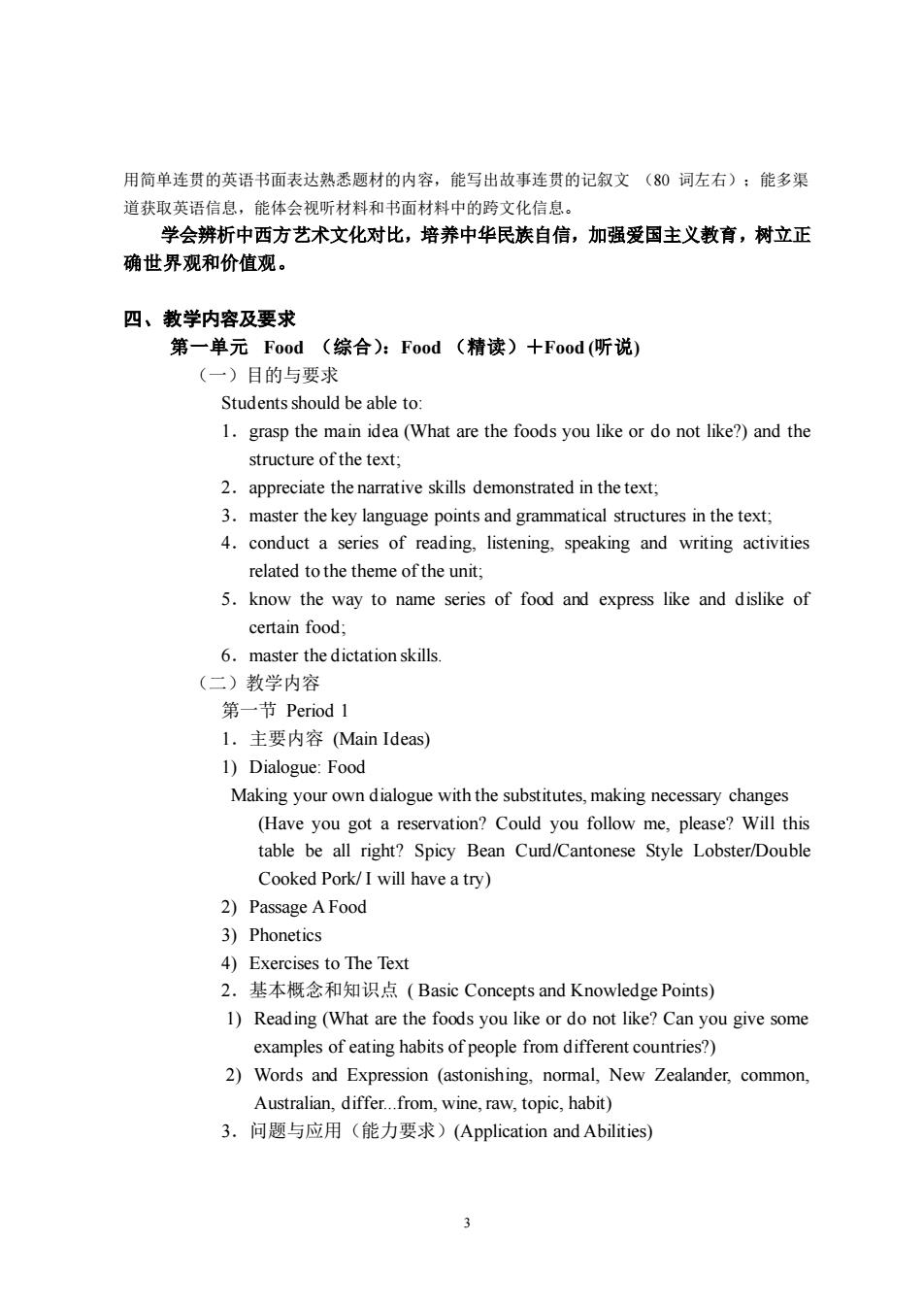
用简单连贯的英语书面表达熟悉题材的内容,能写出故事连贯的记叙文(80词左右):能多渠 道获取英语信息,能体会视听材料和书面材料中的跨文化信息。 学会辨析中西方艺术文化对比,培养中华民族自信,加强爱国主义教有,树立正 确世界观和价值观。 四、教学内容及要求 第一单元Food(综合):Food(精读)+Food(听说) (一)目的与要求 Students should be able to 1.grasp the main idea (What are the foods you like or do not like?)and the structure of the text. 2.appreciate the narrative skills demonstrated in the text; 3.master the key language points and grammatical structures in the text, 4.conduct a series of reading,listening.speaking and writing activities related to the theme of the unit 5.know the way to name series of food and express like and dislike of certain food: 6.master the dictationskills (二)教学内容 第一节Period1 L.主要内容(Main Ideas) 1)Dialogue:Food Making your own dialogue with the substitutes,making necessary changes (Have you got a reservation?Could you follow me,please?Will this table be all right?Spicy Bean Curd/Cantonese Style Lobster/Double Cooked Pork/I will have a try) 2)Passage AFood 3)Phonetics 4)Exercises to The Text 2.基本概念和知识点(Basic Concepts and Knowledge Points) 1)Reading(What are the foods you like or do not like?Can you give some examples of eating habits of people from different countries?) 2)Words and Expression (astonishing,normal,New Zealander,common. Australian,differ.from,wine,raw,topic,habit) 3.问题与应用(能力要求)(Application and Abilities) 3
3 用简单连贯的英语书面表达熟悉题材的内容,能写出故事连贯的记叙文 (80 词左右);能多渠 道获取英语信息,能体会视听材料和书面材料中的跨文化信息。 学会辨析中西方艺术文化对比,培养中华民族自信,加强爱国主义教育,树立正 确世界观和价值观。 四、教学内容及要求 第一单元 Food (综合):Food (精读)+Food (听说) (一)目的与要求 Students should be able to: 1.grasp the main idea (What are the foods you like or do not like?) and the structure of the text; 2.appreciate the narrative skills demonstrated in the text; 3.master the key language points and grammatical structures in the text; 4.conduct a series of reading, listening, speaking and writing activities related to the theme of the unit; 5.know the way to name series of food and express like and dislike of certain food; 6.master the dictation skills. (二)教学内容 第一节 Period 1 1.主要内容 (Main Ideas) 1) Dialogue: Food Making your own dialogue with the substitutes, making necessary changes (Have you got a reservation? Could you follow me, please? Will this table be all right? Spicy Bean Curd/Cantonese Style Lobster/Double Cooked Pork/ I will have a try) 2) Passage A Food 3) Phonetics 4) Exercises to The Text 2.基本概念和知识点 ( Basic Concepts and Knowledge Points) 1) Reading (What are the foods you like or do not like? Can you give some examples of eating habits of people from different countries?) 2) Words and Expression (astonishing, normal, New Zealander, common, Australian, differ...from, wine, raw, topic, habit) 3.问题与应用(能力要求)(Application and Abilities)
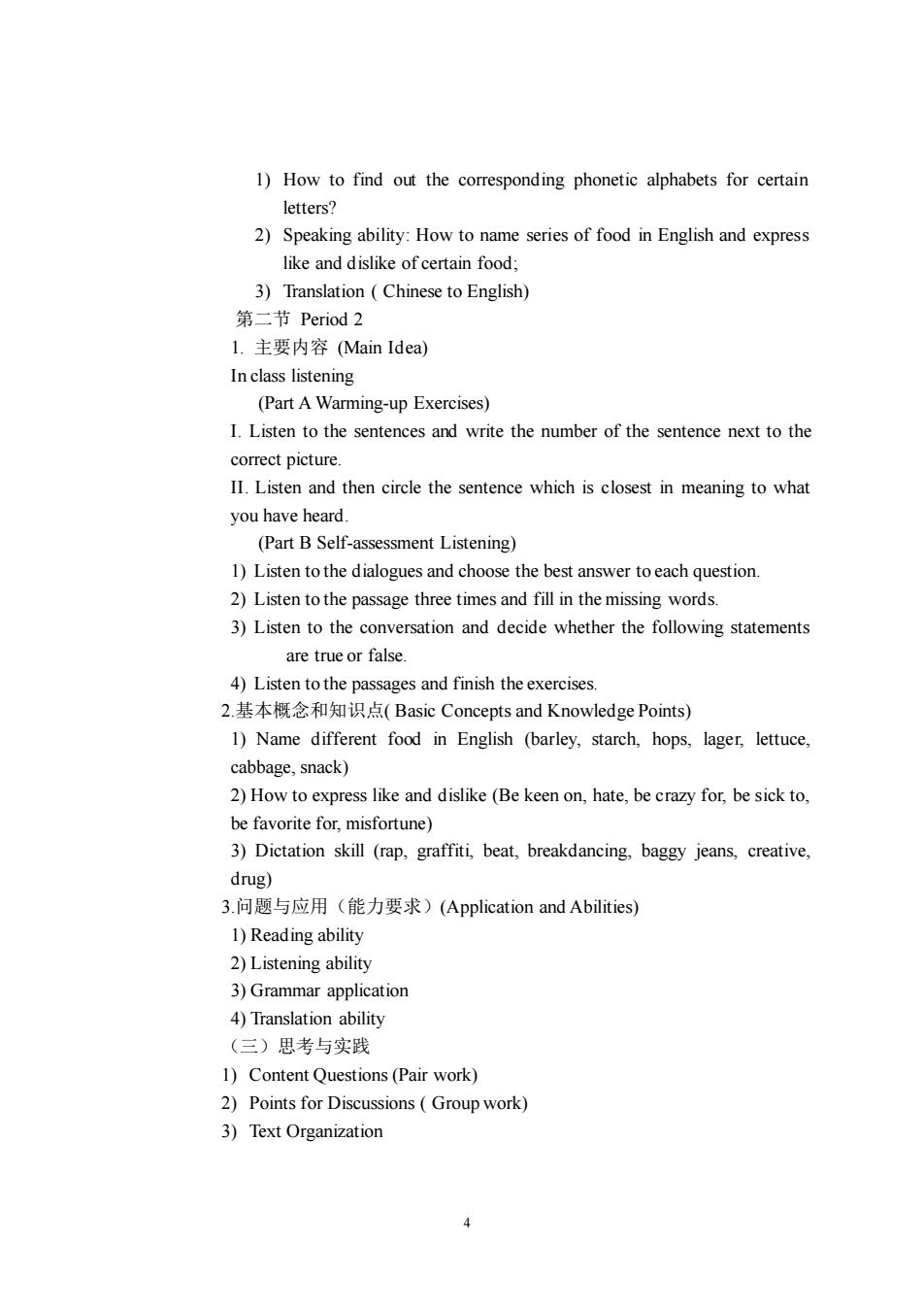
1)How to find out the corresponding phonetic alphabets for certain letters? 2)Speaking ability:How to name series of food in English and express like and dislike of certain food 3)Translation (Chinese to English) 第二节Period2 L.主要内容Main Idea) In class listening (Part A Warming-up Exercises) I.Listen to the sentences and write the number of the sentence next to the correct picture. II.Listen and then circle the sentence which is closest in meaning to what you have heard. (Part B Self-assessment Listening) 1)Listen to the dialogues and choose the best answer toeach question 2)Listen to the passage three times and fill in the missing words. 3)Listen to the conversation and decide whether the following statements are true or false 4)Listen to the passages and finish the exercises 2.基本概念和知识点(Basic Concepts and Knowledge Points) 1)Name different food in English (barley,starch,hops,lager,lettuce cabbage.snack) 2)How to express like and dislike(Be keen on,hate,be crazy for,be sick to be favorite for.misfortune) 3)Dictation skill (rap.graffiti,beat,breakdancing.baggy jeans,creative drug) 3.问题与应用(能力要求)(Application and Abilities) 1)Reading ability 2)Listening ability 3)Grammar application 4)Translation ability (三)思考与实我 1)Content Questions(Pair work) 2)Points for Discussions(Group work) 3)Text Organization 4
4 1) How to find out the corresponding phonetic alphabets for certain letters? 2) Speaking ability: How to name series of food in English and express like and dislike of certain food; 3) Translation ( Chinese to English) 第二节 Period 2 1. 主要内容 (Main Idea) In class listening (Part A Warming-up Exercises) I. Listen to the sentences and write the number of the sentence next to the correct picture. II. Listen and then circle the sentence which is closest in meaning to what you have heard. (Part B Self-assessment Listening) 1) Listen to the dialogues and choose the best answer to each question. 2) Listen to the passage three times and fill in the missing words. 3) Listen to the conversation and decide whether the following statements are true or false. 4) Listen to the passages and finish the exercises. 2.基本概念和知识点( Basic Concepts and Knowledge Points) 1) Name different food in English (barley, starch, hops, lager, lettuce, cabbage, snack) 2) How to express like and dislike (Be keen on, hate, be crazy for, be sick to, be favorite for, misfortune) 3) Dictation skill (rap, graffiti, beat, breakdancing, baggy jeans, creative, drug) 3.问题与应用(能力要求)(Application and Abilities) 1) Reading ability 2) Listening ability 3) Grammar application 4) Translation ability (三)思考与实践 1) Content Questions (Pair work) 2) Points for Discussions ( Group work) 3) Text Organization
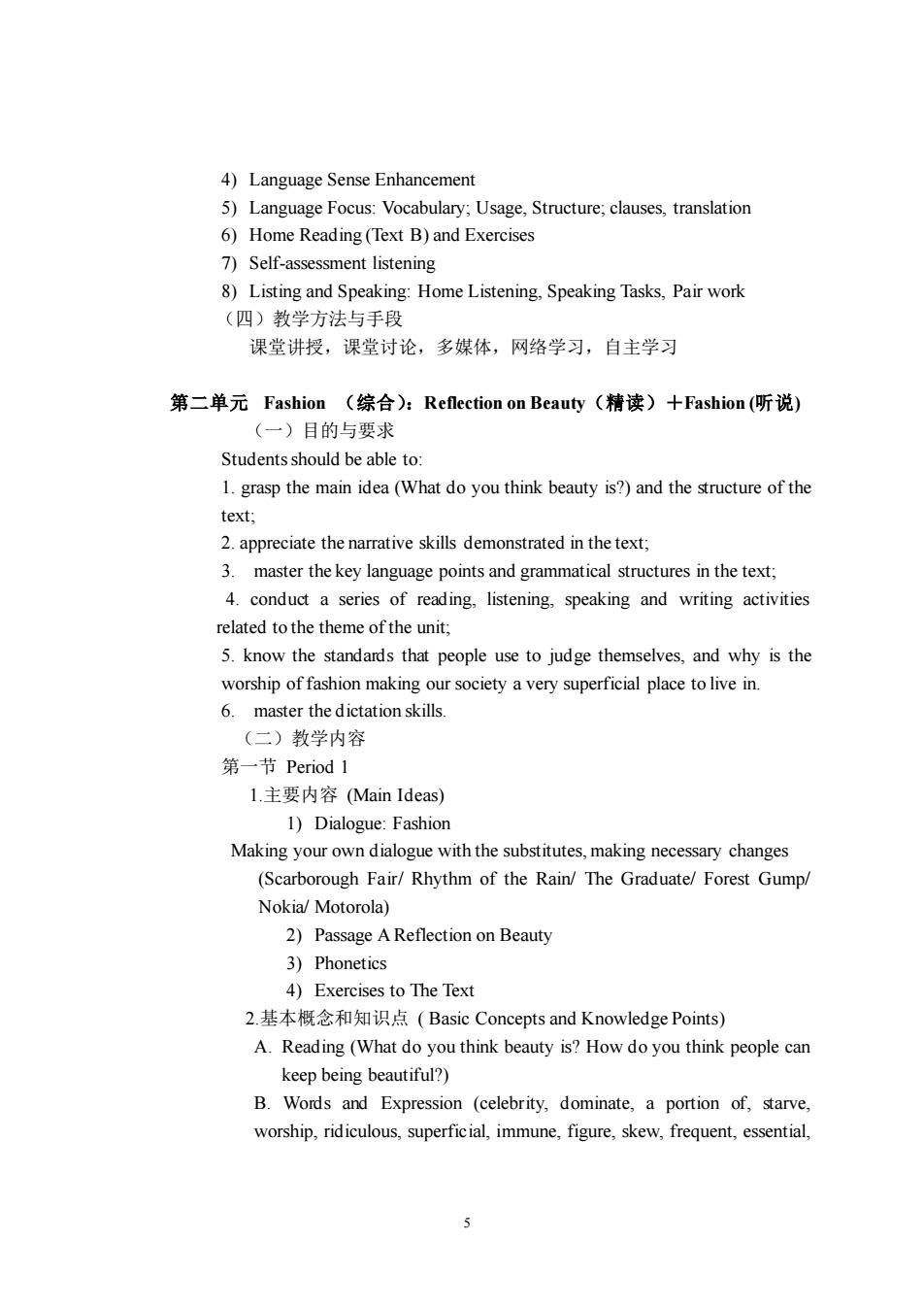
4)Language Sense Enhancement 5)Language Focus:Vocabulary;Usage,Structure:clauses,translation 6)Home Reading (Text B)and Exercises 7)Self-assessment listening 8)Listing and Speaking:Home Listening,Speaking Tasks,Pair work (四)教学方法与手段 课堂讲授,课堂讨论,多媒体,网络学习,自主学习 第二单元Fashion(综合):Refection on Beauty(精读)十Fashion(所说) (一)目的与要求 Students should be able to 1.grasp the main idea(What do you think beauty is?)and the structure of the text. 2.appreciate the narrative skills demonstrated in the text: 3 master the key language points and grammatical structures in the text; 4.conduct a series of reading,listening,speaking and writing activities related to the theme of the unit. 5.know the standards that people use to judge themselves,and why is the worship of fashion making our society a very superficial place to live in. 6.master the dictation skills. (二)教学内容 第一节Period1 l.主要内容(Main Ideas) 1)Dialogue:Fashion Making your own dialogue with the substitutes,making necessary changes (Scarborough Fair/Rhythm of the Rain/The Graduate/Forest Gump/ Nokia/Motorola) 2)Passage A Reflection on Beauty 3)Phonetics 4)Exercises to The Text 2.基本概念和知识点(Basic Concepts and Knowledge Points) A.Reading(What do you think beauty is?How do you think people can keep being beautiful?) B.Words and Expression (celebrity,dominate.a portion of,starve worship,ridiculous,superficial,immune,figure,skew,frequent,essential, 5
5 4) Language Sense Enhancement 5) Language Focus: Vocabulary; Usage, Structure; clauses, translation 6) Home Reading (Text B) and Exercises 7) Self-assessment listening 8) Listing and Speaking: Home Listening, Speaking Tasks, Pair work (四)教学方法与手段 课堂讲授,课堂讨论,多媒体,网络学习,自主学习 第二单元 Fashion (综合):Reflection on Beauty(精读)+Fashion (听说) (一)目的与要求 Students should be able to: 1. grasp the main idea (What do you think beauty is?) and the structure of the text; 2. appreciate the narrative skills demonstrated in the text; 3. master the key language points and grammatical structures in the text; 4. conduct a series of reading, listening, speaking and writing activities related to the theme of the unit; 5. know the standards that people use to judge themselves, and why is the worship of fashion making our society a very superficial place to live in. 6. master the dictation skills. (二)教学内容 第一节 Period 1 1.主要内容 (Main Ideas) 1) Dialogue: Fashion Making your own dialogue with the substitutes, making necessary changes (Scarborough Fair/ Rhythm of the Rain/ The Graduate/ Forest Gump/ Nokia/ Motorola) 2) Passage A Reflection on Beauty 3) Phonetics 4) Exercises to The Text 2.基本概念和知识点 ( Basic Concepts and Knowledge Points) A. Reading (What do you think beauty is? How do you think people can keep being beautiful?) B. Words and Expression (celebrity, dominate, a portion of, starve, worship, ridiculous, superficial, immune, figure, skew, frequent, essential
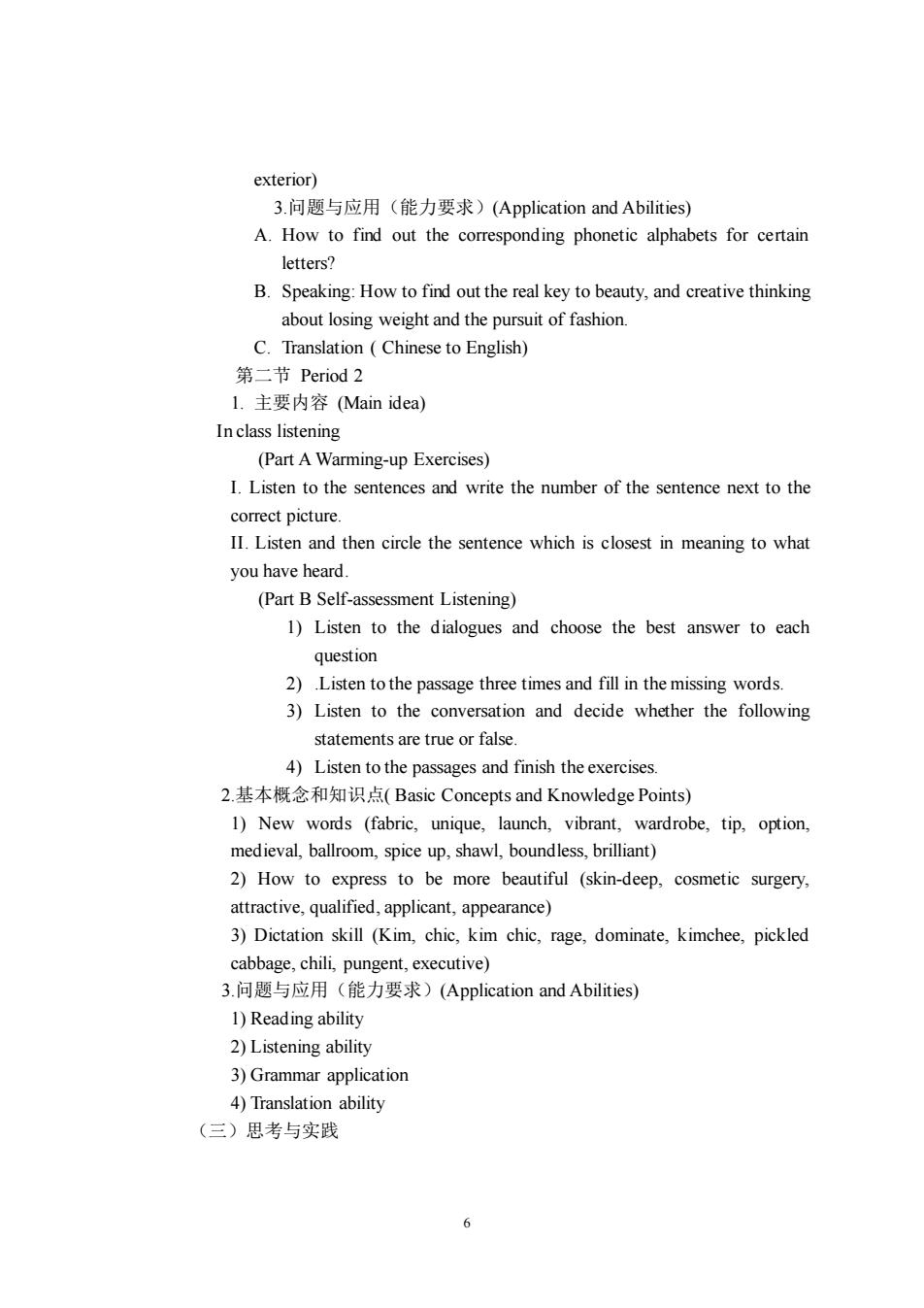
exterior) 3.问题与应用(能力要求)(Application and Abilities) A.How to find out the corresponding phonetic alphabets for certain letters? B.Speaking:How to find out the real key to beauty,and creative thinking about losing weight and the pursuit of fashion. C.Translation(Chinese to English) 第二节Period2 L.主要内容(Main idea) Inclass listening (Part A Warming-up Exercises) 1.Listen to the sentences and write the number of the sentence next to the correct picture. II.Listen and then circle the sentence which is closest in meaning to what you have heard. (Part B Self-assessment Listening) 1)Listen to the dialogues and choose the best answer to each question 2)Listen to the passage three times and fill in the missing words. 3)Listen to the conversation and decide whether the following statements are true or false 4)Listen to the passages and finish the exercises. 2.基本概念和知识点(Basic Concepts and Knowledge Points) 1)New words (fabric,unique,launch,vibrant,wardrobe,tip,option, medieval,ballroom,spice up.shawl,boundless,brilliant) 2)How to express to be more beautiful (skin-deep,cosmetic surgery. attractive,qualified,applicant,appearance) 3)Dictation skill (Kim,chic,kim chic,rage,dominate,kimchee,pickled cabbage,chili,pungent,executive) 3.问题与应用(能力要求)(Application and Abilities) 1)Reading ability 2)Listening ability 3)Grammar application 4)Translation ability (三)思考与实践
6 exterior) 3.问题与应用(能力要求)(Application and Abilities) A. How to find out the corresponding phonetic alphabets for certain letters? B. Speaking: How to find out the real key to beauty, and creative thinking about losing weight and the pursuit of fashion. C. Translation ( Chinese to English) 第二节 Period 2 1. 主要内容 (Main idea) In class listening (Part A Warming-up Exercises) I. Listen to the sentences and write the number of the sentence next to the correct picture. II. Listen and then circle the sentence which is closest in meaning to what you have heard. (Part B Self-assessment Listening) 1) Listen to the dialogues and choose the best answer to each question 2) .Listen to the passage three times and fill in the missing words. 3) Listen to the conversation and decide whether the following statements are true or false. 4) Listen to the passages and finish the exercises. 2.基本概念和知识点( Basic Concepts and Knowledge Points) 1) New words (fabric, unique, launch, vibrant, wardrobe, tip, option, medieval, ballroom, spice up, shawl, boundless, brilliant) 2) How to express to be more beautiful (skin-deep, cosmetic surgery, attractive, qualified, applicant, appearance) 3) Dictation skill (Kim, chic, kim chic, rage, dominate, kimchee, pickled cabbage, chili, pungent, executive) 3.问题与应用(能力要求)(Application and Abilities) 1) Reading ability 2) Listening ability 3) Grammar application 4) Translation ability (三)思考与实践
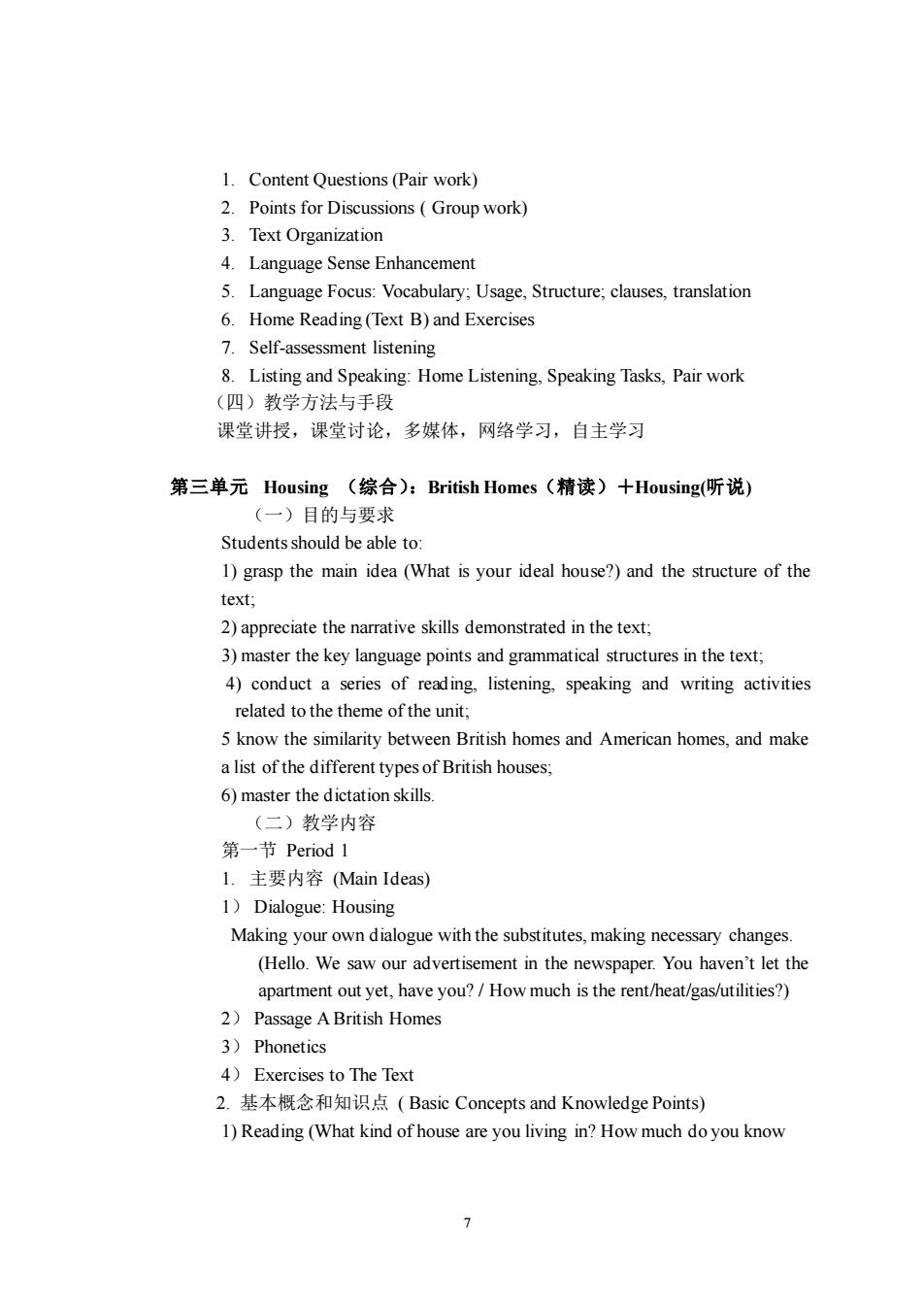
1 Content Questions (Pair work) 2.Points for Discussions(Group work) 3.Text Organization 4.Language Sense Enhancement 5.Language Focus:Vocabulary;Usage,Structure;clauses,translation 6.Home Reading (Text B)and Exercises 7.Self-assessment listening 8.Listing and Speaking:Home Listening.Speaking Tasks,Pair work (四)教学方法与手段 课堂讲授,课堂讨论,多媒体,网络学习,自主学习 第三单元Housing(综合):British Homes(精读)+Housing(听说) (一)目的与要求 Students should be able to: 1)grasp the main idea(What is your ideal house?)and the structure of the text 2)appreciate the narrative skills demonstrated in the text: 3)master the key language points and grammatical structures in the text; 4)conduct a series of reading listening,speaking and writing activities related to the theme of the unit; 5 know the similarity between British homes and American homes,and make a list of the different types of British houses: 6)master the dictation skills. (二)教学内容 第一节Period1 1.主要内容(Main Ideas) 1)Dialogue:Housing Making your own dialogue with the substitutes,making necessary changes (Hello.We saw our advertisement in the newspaper.You haven't let the apartment out yet,have you?/How much is the rent/heat/gas/utilities?) 2)Passage ABritish Homes 3)Phonetics 4)Exercises to The Text 2.基本概念和知识点(Basic Concepts and Knowledge Points) 1)Reading(What kind of house are you living in?How much do you know 7
7 1. Content Questions (Pair work) 2. Points for Discussions ( Group work) 3. Text Organization 4. Language Sense Enhancement 5. Language Focus: Vocabulary; Usage, Structure; clauses, translation 6. Home Reading (Text B) and Exercises 7. Self-assessment listening 8. Listing and Speaking: Home Listening, Speaking Tasks, Pair work (四)教学方法与手段 课堂讲授,课堂讨论,多媒体,网络学习,自主学习 第三单元 Housing (综合):British Homes(精读)+Housing(听说) (一)目的与要求 Students should be able to: 1) grasp the main idea (What is your ideal house?) and the structure of the text; 2) appreciate the narrative skills demonstrated in the text; 3) master the key language points and grammatical structures in the text; 4) conduct a series of reading, listening, speaking and writing activities related to the theme of the unit; 5 know the similarity between British homes and American homes, and make a list of the different types of British houses; 6) master the dictation skills. (二)教学内容 第一节 Period 1 1. 主要内容 (Main Ideas) 1) Dialogue: Housing Making your own dialogue with the substitutes, making necessary changes. (Hello. We saw our advertisement in the newspaper. You haven’t let the apartment out yet, have you? / How much is the rent/heat/gas/utilities?) 2) Passage A British Homes 3) Phonetics 4) Exercises to The Text 2. 基本概念和知识点 ( Basic Concepts and Knowledge Points) 1) Reading (What kind of house are you living in? How much do you know
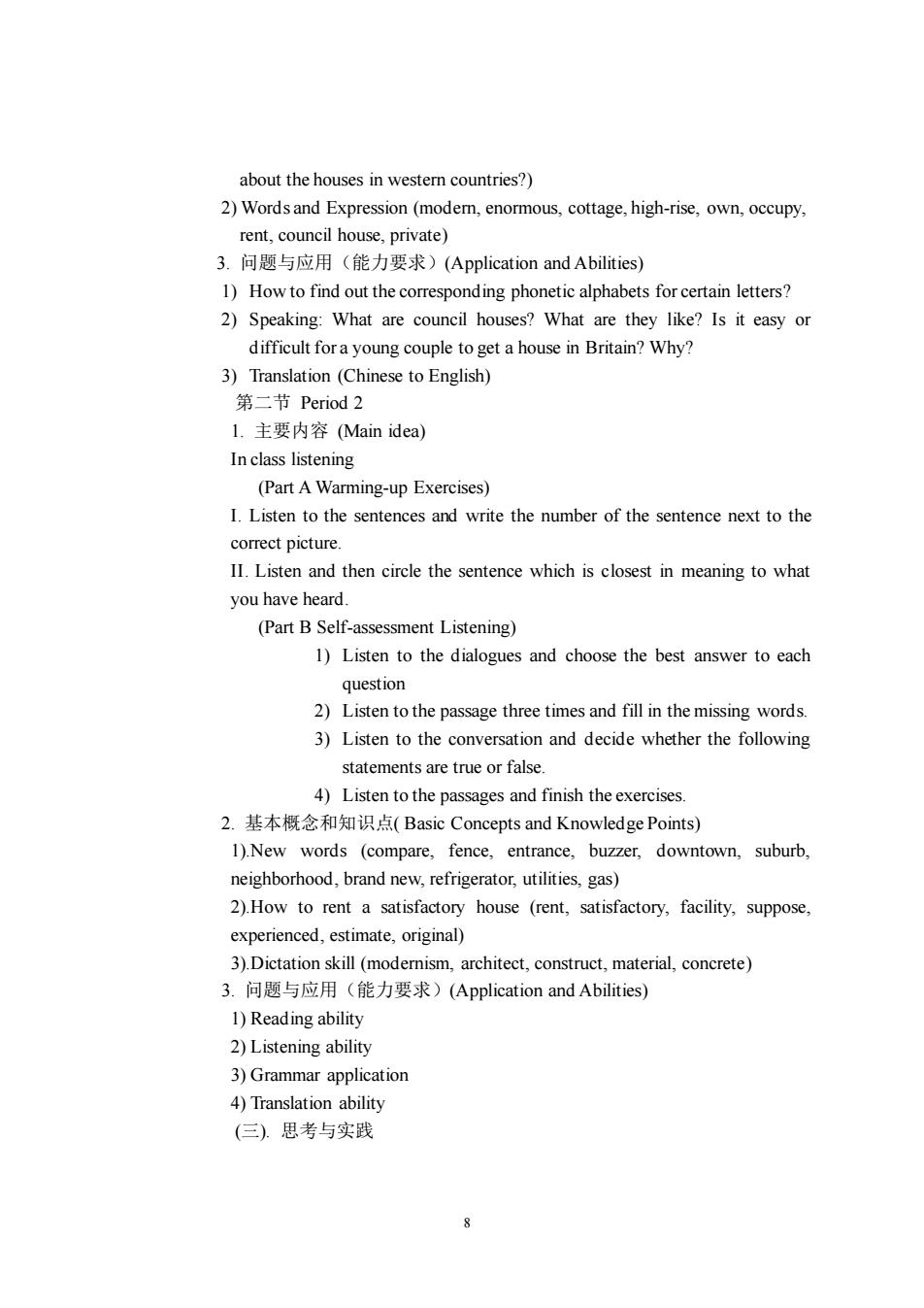
about the houses in western countries?) 2)Wordsand Expression(modem,enormous,cottage,high-rise,own,occupy, rent,council house,private) 3.问题与应用(能力要求)(Application and Abilities) 1)How to find out the corresponding phonetic alphabets for certain letters? 2)Speaking:What are council houses?What are they like?Is it easy or difficult fora young couple to get a house in Britain?Why? 3)Translation(Chinese to English) 第二节Period2 L.主要内容(Main idea) Inclass listening (Part A Warming-up Exercises) I.Listen to the sentences and write the number of the sentence next to the correct picture. II.Listen and then circle the sentence which is closest in meaning to what you have heard. (Part B Self-assessment Listening) 1)Listen to the dialogues and choose the best answer to each question 2)Listen to the passage three times and fill in the missing words. 3)Listen to the conversation and decide whether the following statements are true or false. 4)Listen to the passages and finish the exercises 2.基本概念和知识点(Basic Concepts and Knowledge Points) 1).New words (compare,fence,entrance,buzzer,downtown,suburb neighborhood,brand new,refrigerator,utilities,gas) 2).How to rent a satisfactory house (rent,satisfactory,facility,suppose. experienced,estimate,original) 3).Dictation skill(modernism,architect,construct,material,concrete) 3.问题与应用(能力要求)(Application and Abilities) 1)Reading ability 2)Listening ability 3)Grammar application 4)Translation ability (三).思考与实践
8 about the houses in western countries?) 2) Words and Expression (modern, enormous, cottage, high-rise, own, occupy, rent, council house, private) 3. 问题与应用(能力要求)(Application and Abilities) 1) How to find out the corresponding phonetic alphabets for certain letters? 2) Speaking: What are council houses? What are they like? Is it easy or difficult for a young couple to get a house in Britain? Why? 3) Translation (Chinese to English) 第二节 Period 2 1. 主要内容 (Main idea) In class listening (Part A Warming-up Exercises) I. Listen to the sentences and write the number of the sentence next to the correct picture. II. Listen and then circle the sentence which is closest in meaning to what you have heard. (Part B Self-assessment Listening) 1) Listen to the dialogues and choose the best answer to each question 2) Listen to the passage three times and fill in the missing words. 3) Listen to the conversation and decide whether the following statements are true or false. 4) Listen to the passages and finish the exercises. 2. 基本概念和知识点( Basic Concepts and Knowledge Points) 1).New words (compare, fence, entrance, buzzer, downtown, suburb, neighborhood, brand new, refrigerator, utilities, gas) 2).How to rent a satisfactory house (rent, satisfactory, facility, suppose, experienced, estimate, original) 3).Dictation skill (modernism, architect, construct, material, concrete) 3. 问题与应用(能力要求)(Application and Abilities) 1) Reading ability 2) Listening ability 3) Grammar application 4) Translation ability (三). 思考与实践
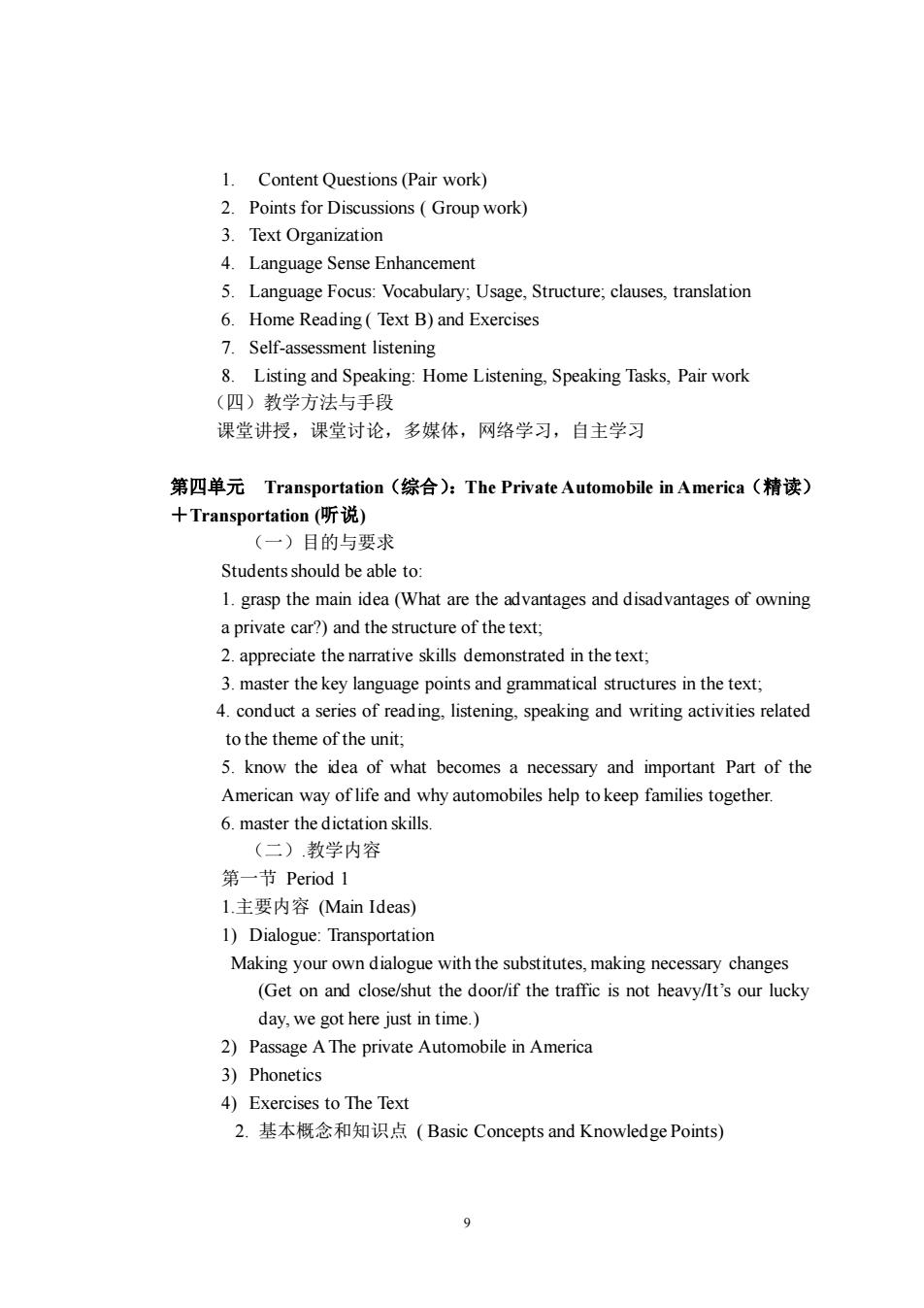
1.Content Questions(Pair work) 2.Points for Discussions (Group work) 3.Text Organization 4.Language Sense Enhancement 5.Language Focus:Vocabulary;Usage,Structure;clauses,translation 6.Home Reading(Text B)and Exercises 7.Self-assessment listening 8.Listing and Speaking:Home Listening.Speaking Tasks,Pair work (四)数学方法与手段 课堂讲授,课堂讨论,多媒体,网络学习,自主学习 第四单元Transportation(综合):The Private Automobile in America(精读) +Transportation(听说) (一)目的与要求 Students should be able to 1.grasp the main idea(What are the advantages and disadvantages of owning a private car?)and the structure of the text; 2.appreciate the narrative skills demonstrated in the text; 3.master the key language points and grammatical structures in the text; 4.conduct a series of reading,listening,speaking and writing activities related to the theme of the unit; 5.know the idea of what becomes a necessary and important Part of the American way of life and why automobiles help to keep families togethe 6 master the dictation skills (二)教学内容 第一节Period1 .主要内容(Main Ideas) 1)Dialogue:Transportation Making your own dialogue with the substitutes,making necessary changes (Get on and close/shut the door/if the traffic is not heavy/It's our lucky day,we got here just in time.) 2)Passage AThe private Automobile in America 3)Phonetics 4)Exercises to The Text 2.基本概念和知识点(Basic Concepts and Knowledge Points)
9 1. Content Questions (Pair work) 2. Points for Discussions ( Group work) 3. Text Organization 4. Language Sense Enhancement 5. Language Focus: Vocabulary; Usage, Structure; clauses, translation 6. Home Reading ( Text B) and Exercises 7. Self-assessment listening 8. Listing and Speaking: Home Listening, Speaking Tasks, Pair work (四)教学方法与手段 课堂讲授,课堂讨论,多媒体,网络学习,自主学习 第四单元 Transportation(综合):The Private Automobile in America(精读) +Transportation (听说) (一)目的与要求 Students should be able to: 1. grasp the main idea (What are the advantages and disadvantages of owning a private car?) and the structure of the text; 2. appreciate the narrative skills demonstrated in the text; 3. master the key language points and grammatical structures in the text; 4. conduct a series of reading, listening, speaking and writing activities related to the theme of the unit; 5. know the idea of what becomes a necessary and important Part of the American way of life and why automobiles help to keep families together. 6. master the dictation skills. (二).教学内容 第一节 Period 1 1.主要内容 (Main Ideas) 1) Dialogue: Transportation Making your own dialogue with the substitutes, making necessary changes (Get on and close/shut the door/if the traffic is not heavy/It’s our lucky day, we got here just in time.) 2) Passage A The private Automobile in America 3) Phonetics 4) Exercises to The Text 2. 基本概念和知识点 ( Basic Concepts and Knowledge Points)
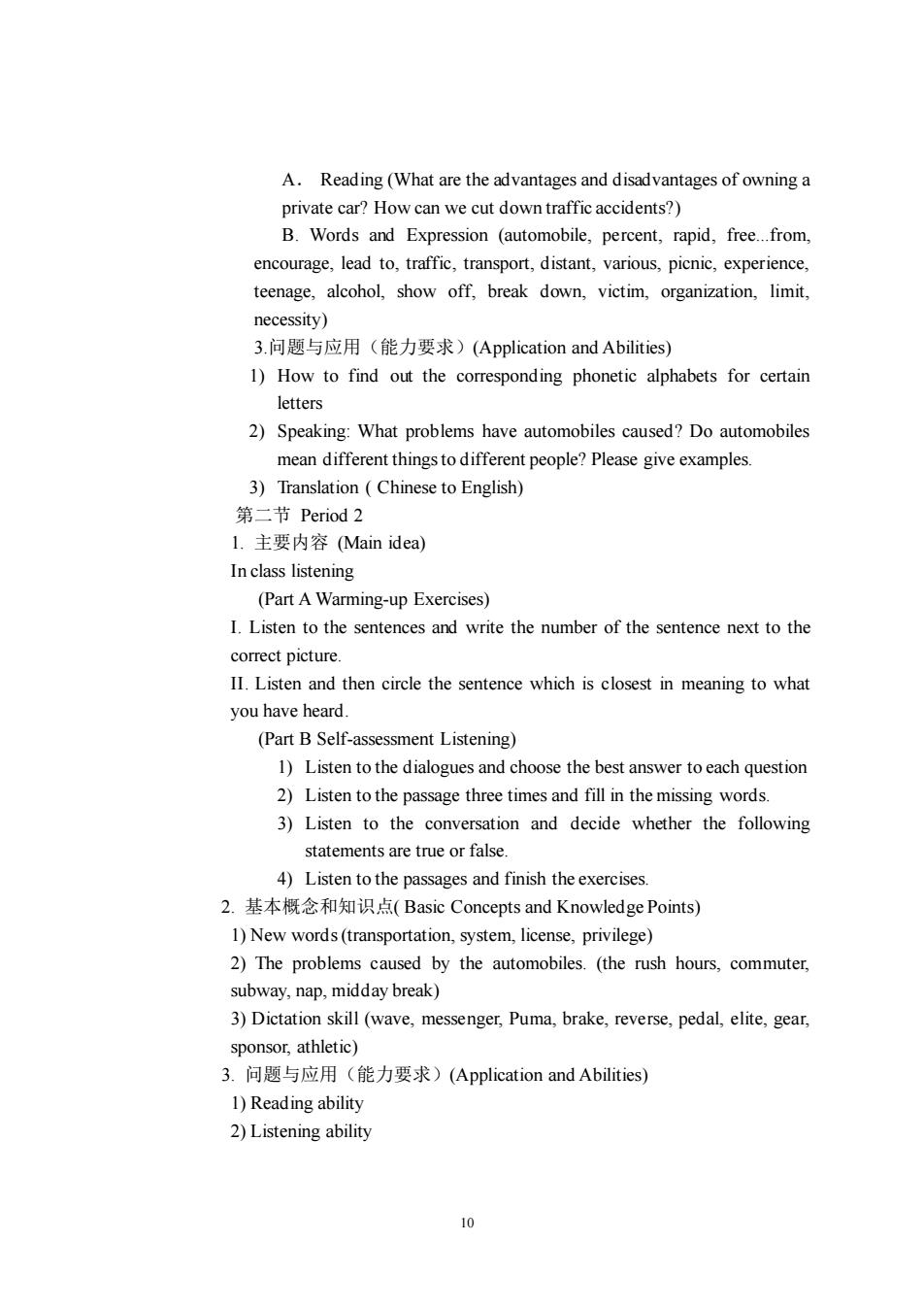
A.Reading(What are the advantages and disadvantages of owning a private car?How can we cut down traffic accidents?) B.Words and Expression (automobile,percent,rapid,free...from, encourage.lead to,traffic,transport,distant,various,picnic,experience. teenage,alcohol,show off,break down,victim,organization,limit, necessity) 3.问题与应用(能力要求)(Application and Abilities) 1)How to find out the corresponding phonetic alphabets for certain letters 2)Speaking:What problems have automobiles caused?Do automobiles mean different thingsto different people?Please give examples. 3)Translation (Chinese to English) 第二节Period2 L.主要内容Main idea) Inclass listening (Part A Warming-up Exercises) I.Listen to the sentences and write the number of the sentence next to the correct picture. I.Listen and then circle the sentence which is closest in meaning to what you have heard. (Part B Self-assessment Listening) 1)Listen to the dialogues and choose the best answer to each question 2)Listen to the passage three times and fill in the missing words 3)Listen to the conversation and decide whether the following statements are true or false 4)Listen to the passages and finish the exercises. 2.基本概念和知识点(Basic Concepts and Knowledge Points) 1)New words(transportation,system,license,privilege) 2)The problems caused by the automobiles.(the rush hours,commuter, subway,nap,midday break) 3)Dictation skill (wave,messenger,Puma,brake,reverse,pedal,elite,gear, sponsor athletic) 3.问题与应用(能力要求)(Application and Abilities) 1)Reading ability 2)Listening ability 10
10 A. Reading (What are the advantages and disadvantages of owning a private car? How can we cut down traffic accidents?) B. Words and Expression (automobile, percent, rapid, free...from, encourage, lead to, traffic, transport, distant, various, picnic, experience, teenage, alcohol, show off, break down, victim, organization, limit, necessity) 3.问题与应用(能力要求)(Application and Abilities) 1) How to find out the corresponding phonetic alphabets for certain letters 2) Speaking: What problems have automobiles caused? Do automobiles mean different things to different people? Please give examples. 3) Translation ( Chinese to English) 第二节 Period 2 1. 主要内容 (Main idea) In class listening (Part A Warming-up Exercises) I. Listen to the sentences and write the number of the sentence next to the correct picture. II. Listen and then circle the sentence which is closest in meaning to what you have heard. (Part B Self-assessment Listening) 1) Listen to the dialogues and choose the best answer to each question 2) Listen to the passage three times and fill in the missing words. 3) Listen to the conversation and decide whether the following statements are true or false. 4) Listen to the passages and finish the exercises. 2. 基本概念和知识点( Basic Concepts and Knowledge Points) 1) New words (transportation, system, license, privilege) 2) The problems caused by the automobiles. (the rush hours, commuter, subway, nap, midday break) 3) Dictation skill (wave, messenger, Puma, brake, reverse, pedal, elite, gear, sponsor, athletic) 3. 问题与应用(能力要求)(Application and Abilities) 1) Reading ability 2) Listening ability